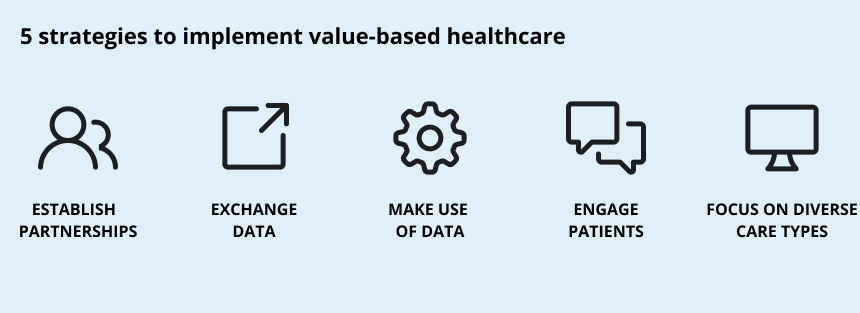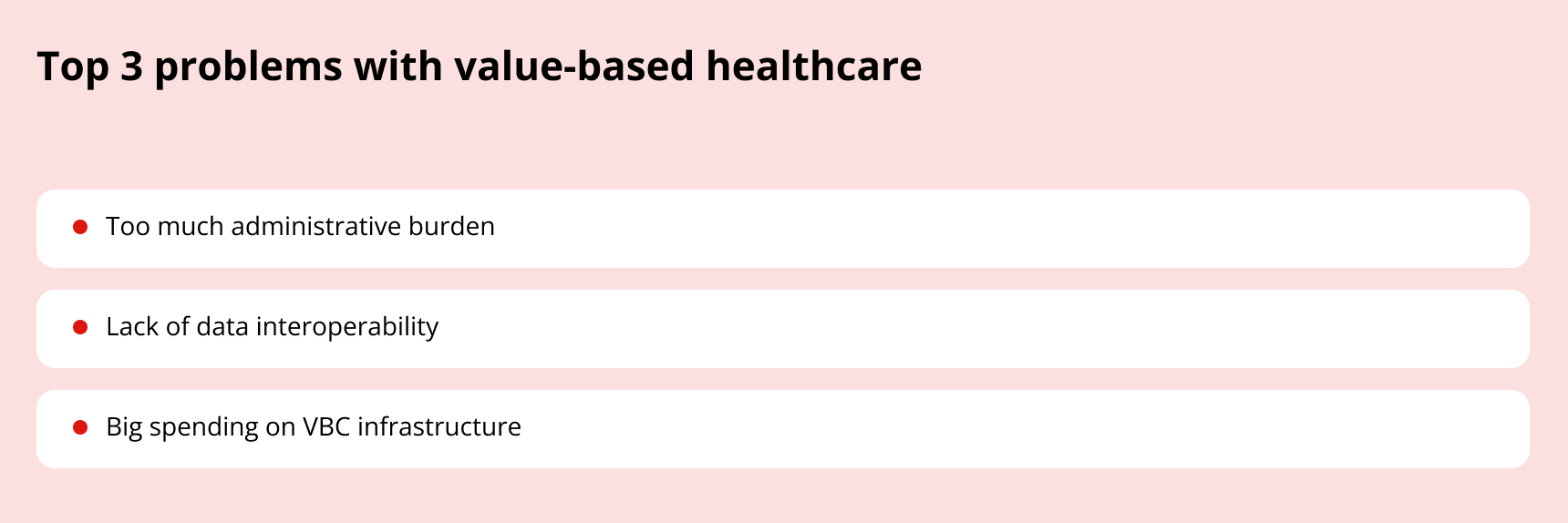Top 5 Strategies to Implement Value-Based Healthcare
Payers are pushing healthcare providers (HCPs) to adopt value-based contracts. Their goal is clear: cut healthcare costs and save money while keeping care standards high. There are no mandatory regulations yet forcing HCPs to accept these contracts. But if providers want to work with top payers and attract more patients, they need to play by the new rules.
The big question is: how to implement value-based care (VBC)? VBC brings new contract types and reimbursement rules. It demands tech investments. Providers must also change how they practice medicine. All these changes need time, effort, and resources.
Digiteum is here to help. We’ll share five strategies to implement value-based healthcare drawing from our experience in medical software development. These tips, along with real-life value-based care solutions, will make the transition smoother and easier for you.
Value-based healthcare is a care delivery model where providers are paid based on patient health outcomes.
The way these payments are calculated is outlined in value-based contracts. Here are the most popular methods.
Pay-for-performance (P4P)
Providers get bonuses or penalties based on how well they meet specific quality measures set by payers.
Example: Medicare’s Hospital Readmissions Reduction Program (HRRP) measures quality by readmission rates. If rates are high, reimbursements are reduced.
Bundled payments
Providers receive one payment for all services during a care episode.
Example: Medicare’s Comprehensive Care for Joint Replacement (CJR) model uses this method for knee replacement surgery. The payment covers everything from pre-op consultations to post-op rehab.
Capitation
Providers receive a fixed payment per patient for a set time, covering all services during that period.
Example: Medicare Advantage health plans use this model. Payments are adjusted based on health status, local costs, and average service use.
Shared savings and risk-based contracts
Payers set financial benchmarks. Providers get extra payments if they deliver effective care below the benchmark.
Example: The Medicare Shared Savings Program (MSSP) involves accountable care organizations (ACOs). These groups coordinate care, share risks, and split savings. If costs stay below the benchmark, providers share the savings. If costs go over the benchmark, they must repay part of the excess.
These examples show that major US payers are pushing for these types of VBC contracts. Their goal? Tie 100% of reimbursements to value by 2030. If providers want to work with these payers, they need to start adapting to the new rules and the VBC healthcare model.
This shift is already underway. In 2023, the APM Measurement Methodology and Results Report measured the adoption of alternative payment models in healthcare. It revealed that only 40.6% are classical fee-for-service (FFS) contracts with no connection to quality or value. The rest contain metrics related to quality.
Let’s see what sets apart the current FFS approach and the new value-based care model.
Quantity vs. quality
Under the FFS model, healthcare providers get paid based on the number of services they deliver. More services mean more profits. That’s why FFS is often blamed for rising healthcare costs.
VBC, on the other hand, focuses on the quality of services provided. HCPs are rewarded for better patient outcomes and efficiency, not for the volume of services. This approach aims to improve care while controlling costs.
Treatment vs. prevention
In traditional fee-for-service healthcare, a lot of money is spent treating the sickest patients in hospitals. There’s much less investment in preventing diseases and keeping patients out of them.
But in value-based care, providers focus on what works best for patients without costing too much. And it’s more cost-effective to prevent illnesses and diagnose them early. VBC aims to avoid expensive hospital visits and shorten hospital stays.
Fragmented care vs. integrated care
Within the FFS model, each provider works in a silo. That’s why data is scattered across different sources. This fragmented approach can harm patients. Studies show more hospitalizations when care isn’t coordinated. Mismanaged medications can cause serious health issues too. Fragmented care also costs more, with lots of unnecessary tests and medications.
In VBC, healthcare providers use technology to connect and share data among different systems. They gather all this data into one central hub, which becomes their main source of information for delivering care across their entire networks.
Digiteum specializes in data integration
Analyzing data for value-based care is complicated. We create solutions that pull data from different places and make it work together smoothly in your systems.
Learn moreLet’s discuss strategies for moving from volume- to value-based care, along with some real-life value-based care solutions.

Establish partnerships
When dealing with chronic diseases, patients often need care from multiple doctors. Medicare and Medicaid report that 40% of patients with chronic conditions see seven or more specialists each year.
Ideally, these specialists should coordinate their work. Without coordination, patients might face redundant tests, answer the same questions repeatedly, and receive conflicting treatments.
VBC aims to improve this coordination. Take a look at Somatus. It’s the largest value-based kidney care company in the US Somatus partners with major health plans and health systems nationwide.
The company sees a big challenge for people with chronic kidney diseases: health inequities and lack of access to quality treatment. Even when they do get treatment, they often need help managing other aspects, like their diet and medications.
To tackle this, Somatus partners with nephrology, cardiology, and primary care groups. They set up local teams that work directly with patients but stay closely connected with doctors. The doctors often work remotely, coordinating care while the local teams, including nurses and dietitians, visit patients at home. This way, they provide comprehensive care and support right where the patients need it.
Exchange data
In healthcare, data sharing is crucial for value-based care to work well. It helps providers master data-driven decision-making in healthcare, share risks and rewards, as well as coordinate care.
When data doesn’t flow smoothly, it leads to fragmented care. Information gets stuck between different providers and payers.
NextGate, a US-based EHR management system, tackles these challenges by linking up different systems. It securely shares patient data under HIPAA agreements. This setup helps healthcare teams access all the patient’s information in one place. It makes care coordination easier and reduces the information overload for doctors.
By making data exchange seamless, NextGate supports VBC initiatives. It helps improve patient outcomes and makes healthcare delivery smoother across different settings.
Make use of data
So, what happens when clinicians have all the patient’s medical history in front of them? The idea is that it helps create the best care plan. But in reality, having too much unorganized information can overwhelm clinicians. They might find it hard to pinpoint the most crucial data for the current patient visit.
That’s why data analytics is so important. Data analytics comes in different forms and helps healthcare providers understand how well treatments work and how much money is being spent.
In value-based care, this means knowing which treatments work well and where costs can be cut.
ChenMed illustrates this well. They focus on providing senior care through their clinics. ChenMed uses technology to gather data from electronic health records and patient input. But they don’t just pull data from different sources. They analyze all this wealth of data. As a result, ChenMed can spot high-risk patients early, tailor care plans to fit individual needs, and keep a close watch on patient outcomes.
This approach not only improves patient care. It also helps ChenMed run its clinics more efficiently and ensures clinic staff provide the right care at the right time. As a result, they reduce healthcare costs without compromising care quality.
Engage patients
No matter how good a treatment plan is, it won’t work if patients don’t follow it between visits, skip check-ups, or forget their medication. To get patients more involved, doctors are using apps, video chats, patient portals, and remote monitoring.
These tools are essential in value-based care. They help patients manage their health between visits. And they also empower clinicians to detect symptoms early and adjust treatments promptly.
Nowadays, lots of products help patients stay engaged and support VBC. One great example is the app for lymphoma patients built by the US Lymphoma Research Foundation, one of Digiteum’s clients.
The app lets users track symptoms, chat with their healthcare team, and work together on treatment plans. It’s easy for anyone to use, whether they’re tech-savvy or not. The app has even earned praise as one of the top new medical apps in the App Store.
Encourage patients to play an active part in their treatment
Digiteum creates tools that help healthcare providers and patients communicate, collaborate, and coordinate their actions.
Explore howPrioritize different types of care
To cut down on costly procedures like long hospital stays, healthcare providers need alternatives. That’s why we’re seeing a shift towards outpatient settings, home care, and digital platforms.
Take CareBridge as an example of value-based care. CareBridge focuses on patients getting home and community-based services (HCBS). They do this very effectively, serving over 19,000 patients at full risk today and recently securing a $140 million financing round.
CareBridge uses advanced technologies like 24/7 clinical support, remote monitoring, and electronic visit verification. These tools help CareBridge deliver the right level of care at home.
As a result, CareBridge reduces unnecessary hospitalizations, cuts down on emergency room visits, and lowers overall costs.

Too much burden on doctors and medical staff
For value-based care, providers must track and report on both quality and cost from various sources. This means handling new administrative tasks while managing both fee-for-service and value-based care models.
Currently, providers spend nearly half their time on paperwork, which leads to burnout and less time for patient care. With each payer having its own rules, this adds even more strain on their systems and processes.
Lack of data interoperability
Data interoperability is a pressing challenge in healthcare. In VBC, the situation gets even more serious with its focus on connecting healthcare professionals and establishing a single data storage which all of them can access.
High investment in VBC infrastructure
VBC requires a big investment in infrastructure — time, money, and strategic planning. Bringing VBC to life also means finding IT professionals who can build the necessary systems. Today, competition for tech talent is fierce across all industries, including healthcare. This competition drives up costs for recruitment, onboarding, and salaries.
These days, finding tech talent is tougher than ever. But don’t worry, Digiteum can help. We’ve been partnering with healthcare companies since 2010, using our expertise to deliver the solutions you need right now.
- Our portfolio includes projects in data management and patient engagement from Diaceutics, Lymphoma Research Foundation, NextGate, Takeda, and many more
- We create products from scratch. We also improve existing ones and work on further integrations
- Digiteum offers a dedicated team for your project or helps you find the tech talent you need. Have other requests? Just let us know, and we’ll take care of them for you
Digiteum is here to answer your questions
Long-term collaboration starts with an open and transparent conversation. Send us a request, and we’ll get back to you within 12 hours.
Contact Digiteum- Healthcare organizations are shifting to new payment models and care approaches. They aim to save costs and improve patient outcomes through value-based care. Payer pressure and potential regulations are driving this change
- Yet, adopting value-based care is tough for healthcare practices. They need to integrate advanced technology everywhere in healthcare. This means investing in infrastructure and collaborating with tech experts
- Need a reliable tech partner to deliver on VBC promises and transform healthcare? Contact Digiteum!
FAQ
- Improving access to care
- Containing costs
- Boosting profits
- Data is scattered. Developers need to build systems that can pull data from various sources.
- Data is unstructured. Over 70% of digital healthcare data is unstructured, like images, X-rays, and clinician notes. Solutions need to extract and use this data.
- Data is abundant. VBC solutions should help find insights in this wealth of data without overwhelming doctors.







